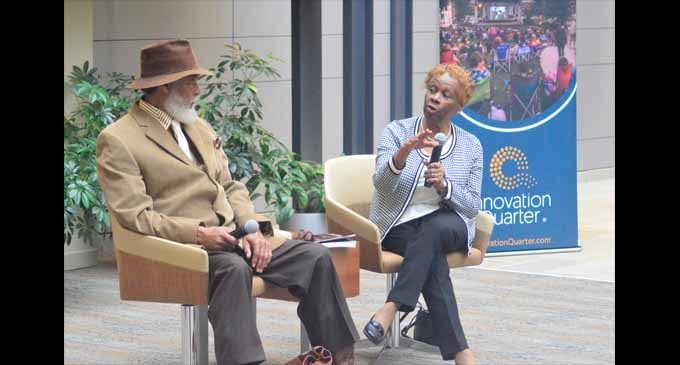Black History event details local sit-in movement
James Webster, son-in-law of Carl Matthews, the man who started the local sit-it protest, sits down with local historian Barbara Morris to discuss the movement and the impact it had on the community.

Dozens of people received an impromptu history lesson earlier this week when they came together to explore the black history of Winston-Salem during a cultural fair, film screening and panel discussion held at the Innovation Quarter on Tuesday, Feb. 18.
The event, hosted by the Winston-Salem Black Chamber of Commerce, Preservation Forsyth, Triad Cultural Arts, International Civil Rights Center & Museum, Winston-Salem African American Archive, and Old Salem Museums & Gardens, began with the local history and cultural fair where the public had the opportunity to learn about the rich black history of Winston-Salem and organizations in the area that preserve and celebrate our local history and culture.
Following the cultural fair, attendees watched the film “I Am Not My Brother’s Keeper: Leadership and Civil Rights in Winston-Salem, North Carolina.” The film, which was written and directed by Mary M. Dalton and Susan Faust, tells how Carl W. Matthews, a student at Winston-Salem Teachers College at that time (now Winston-Salem State University), led a protest by taking seats at a lunch counter at S.H. Kress Department Store in 1960, starting a three-month-long action that ended in the successful desegregation of lunch counters in the city. The film, which was released in 2001, uses interviews with many of the students involved in the protest, professors and others to provide a sense of what the movement was to the students and how it shaped their lives.
After the screening of the film, local historian and longtime Winston-Salem residents Barbara Morris and James Webster, son-in-law of Carl Matthews, sat down to discuss the impact of the movement and answer questions from the crowd. Before delving into the conversation, Webster let it be known that although the Greensboro Four are recognized as the first to start the sit-in movement, the first sit-in victory came right here in Winston-Salem.
“Let me tell you this because they don’t tell you this, Carl Matthews had the first victory sit-in. He was the first to eat,” Webster said. “He sat down and he ate on May 25. What you must also understand is that Greensboro people didn’t eat until July 25; that’s almost two months later. We don’t hear that, but that’s what makes Winston-Salem so special; we were not the first, but we were the first to be successful.”
To begin the conversation, moderator Abrea Armstrong asked Morris what was it like for her during the sit-in movement. At the time of the movement, Morris was only 16 years old, but she remembers how the community, local businesses, and even churches rallied around the students from Winston-Salem Teachers College and Wake Forest College (now Wake Forest University) and marched through the streets of the city to show their support. She said, “As a young teenager, only 16, I marched every night.
“We marched from every part of Winston-Salem. We marched from Happy Hill Gardens to downtown, from King Court, Boston, really from all the black neighborhoods,” Morris continued. “The church also played a major part in the Civil Rights Movement because every night before we marched, we went to a church and had prayer and mapped out our plan. We were not just running around the city, we were a controlled group.”
In honor of the historic sit-in, on Sunday, Feb. 23, a community commemoration vigil will be held in downtown Winston-Salem to mark the 60th anniversary of the event. The vigil, which is scheduled to begin at 3 p.m., will begin in front of the Millennium Center, 101 West 5th Street, and end at the corner of Fourth and Liberty Streets where a historical marker designates the site as the location of the “First sit-in victory in North Carolina.”










